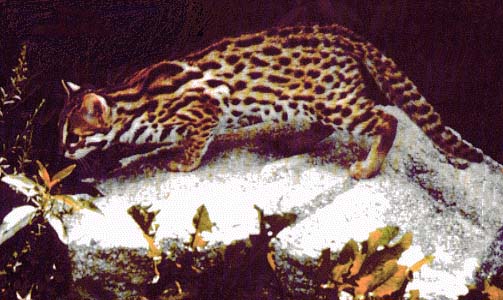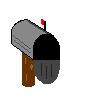
Pictured is an Asian Leopard Cat previously owned by Judee Frank. Notice his white undersides, white spots on the back of his ears and extremely intense markings. Taken from Gene Johnson Ducote's book, Getting To Know The Bengal Cat
The original was developed in the early 1960's by Jean Mill, now of Covina,
California. She had just purchased her first wild Asian Leopard cat while living in Yuma,
Arizona. It was completely by accident that she stumbled onto the discovery. The Leopard
seemed lonely in the big cage by herself, so Jean put a black tomcat in with her, knowing the
two couldn't breed.Contrary to the experts' belief and knowledge, the two produced an
offspring. It was a female they called "Kin Kin." Believing that Kin Kin would be
sterile, as nature had intended to guard against interspecies mutation, the experts were surprised
to discover that the little hybrid had produced a second generation litter of her own!
In 1965, when Jean Mill lost her husband she temporarily shelved her work as a Bengal
developer. There are to date no remaining bloodlines of these original Bengal cats.

Pictured is an Asian Leopard Cat previously owned by Judee
Frank. Notice
his white undersides, white spots on the back of his ears and extremely intense markings. Taken
from Gene Johnson Ducote's book, Getting To Know The Bengal Cat
 Today's Bengals are typically a cross between the Wild
Asian Leopard cat and a
domestic. Usually a
Siamese, or
Abyssinian are
used, as well as Ocicats
and other short haired
Tabby varieties. Although the Ocicat's name would indicate that its origin is from the actual
Ocelot, there is no wild blood whatsoever. The California Spangled cat is spotted as well as the
Egyptian Mau, but
both are also purely domestic. Pictured is an Asian Leopard Cat owned by
Bob Torqucto. Taken from Gene Johnson Ducote's book, Getting To Know The Bengal
Cat
Today's Bengals are typically a cross between the Wild
Asian Leopard cat and a
domestic. Usually a
Siamese, or
Abyssinian are
used, as well as Ocicats
and other short haired
Tabby varieties. Although the Ocicat's name would indicate that its origin is from the actual
Ocelot, there is no wild blood whatsoever. The California Spangled cat is spotted as well as the
Egyptian Mau, but
both are also purely domestic. Pictured is an Asian Leopard Cat owned by
Bob Torqucto. Taken from Gene Johnson Ducote's book, Getting To Know The Bengal
Cat
 bengals@scctel.com
bengals@scctel.com Copyright © Sally Dockstader/Marilyn Fish 1997